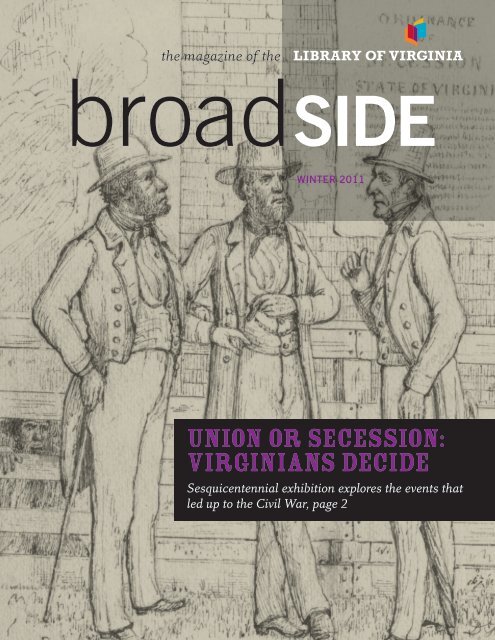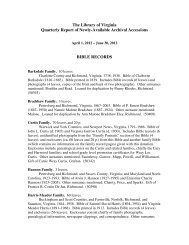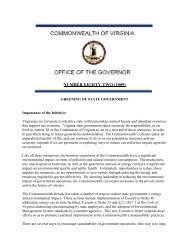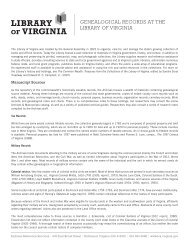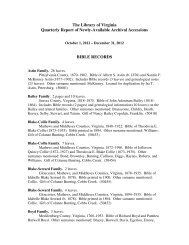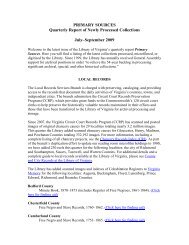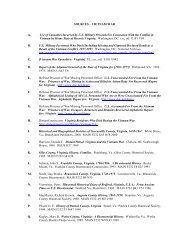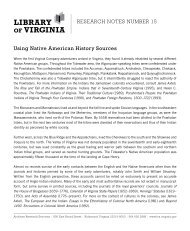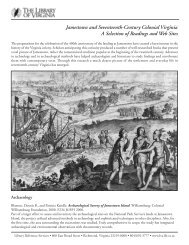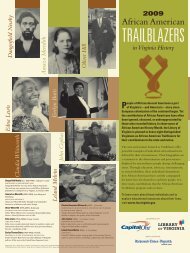UNION OR SECESSION: VIRGINIANS DECIDE - Library of Virginia ...
UNION OR SECESSION: VIRGINIANS DECIDE - Library of Virginia ...
UNION OR SECESSION: VIRGINIANS DECIDE - Library of Virginia ...
- No tags were found...
Create successful ePaper yourself
Turn your PDF publications into a flip-book with our unique Google optimized e-Paper software.
DID YOU KNOW?Fascinating facts about the start <strong>of</strong> the Civil War••••Even before Abraham Lincoln was inaugurated as president <strong>of</strong> the UnitedStates on March 4, 1861, seven Southern states had seceded from the Union—South Carolina, Mississippi, Florida, Alabama, Georgia, Louisiana, and Texas.Former U.S. president John Tyler led a peace conference in Washington, D.C.,that sought a compromise to reunite the nation.Most <strong>of</strong> the men elected to the convention in February 1861 wanted <strong>Virginia</strong>to stay in the United States.Robert E. Lee could have commanded the Union army. He turned downan opportunity to command the U.S. Army, resigned his commission, andaccepted command <strong>of</strong> <strong>Virginia</strong>’s forces.EXHIBITIONSspeak for themselves. What were they saying and doing during the secessionwinter? We knew that military history would be well represented by otherinstitutions—especially battlefield sites. So the question was: What could webest contribute to the sesquicentennial that wasn’t marching and shooting?”The team’s work, including that <strong>of</strong> the <strong>Library</strong>’s talented graphic designstaff, seems to have paid <strong>of</strong>f according to some excellent reviews frommembers <strong>of</strong> the media and visitors such as Anne Sterling, who recentlywrote: “A smashing exhibit! I was totally drawn in and fascinated bythe details you and your team selected, to say nothing <strong>of</strong> the inspiredpresentation <strong>of</strong> them.”Educational programs for the exhibition have been generouslysponsored by Middleburg Trust Company. The <strong>Library</strong> is also gratefulfor the support <strong>of</strong> the Richard S Reynolds Foundation and the members<strong>of</strong> the <strong>Library</strong> Foundation’s Semper <strong>Virginia</strong> Society, who helped makethe exhibition possible.Union or Secession: <strong>Virginia</strong>ns Decide is accompanied byan educational Web site and events such as tours, talks, andlimited display <strong>of</strong> the rare and fragile Flegenheimer parchment<strong>of</strong> <strong>Virginia</strong>’s Ordinance <strong>of</strong> Secession, (see article on page 4). Formore information, visit www.virginiamemory.com/va1861 or call804.692.3901.<strong>Virginia</strong> was central to Americanidentity for its role in the founding<strong>of</strong> the United States—both sides wanted toclaim <strong>Virginia</strong>’s historical legacy.POSTEDThis broadside from the <strong>Library</strong>’s Special Collections callsfor a “Mass Meeting <strong>of</strong> the people” in Lexington, <strong>Virginia</strong>.It’s dated April 17, 1861, the day <strong>Virginia</strong> seceded fromthe Union.WINTER 2011 broadSIDE 3
EXHIBITION DOCUMENT<strong>Virginia</strong>’s Ordinance <strong>of</strong> SecessionDon’t miss this limited opportunity to view the fragile andfascinating Flegenheimer parchmentTHE CEREMONIAL COPYDrawn on parchment, or treated animal skin, the Flegenheimer ordinanceis sensitive not only to light but also to changes in temperature andhumidity levels.Display <strong>of</strong> the Ordinance <strong>of</strong> SecessionApril 9 | 10:00 am–4:00 pmLocation: Special Collections as part <strong>of</strong> the 2011 VoorheesLecture on the History <strong>of</strong> CartographyApril 16, June 28, and October 25 | 9:00 am–5:00 pmLocation: LobbyThe <strong>Library</strong> <strong>of</strong> <strong>Virginia</strong> houses a unique and importantdocument related to <strong>Virginia</strong>’s Civil War history—theOrdinance <strong>of</strong> Secession. On April 17, 1861, after months <strong>of</strong>debate, the <strong>Virginia</strong> Convention <strong>of</strong> 1861 voted 88 to 55 to repeal<strong>Virginia</strong>’s ratification <strong>of</strong> the Constitution <strong>of</strong> the United States,effectively withdrawing from the Union. For final approval,the secession referendum had to be submitted to the electoratefor ratification on May 23. Secessionists carried the day, and<strong>Virginia</strong> was <strong>of</strong>ficially out <strong>of</strong> the Union. The secretary <strong>of</strong>the <strong>Virginia</strong> Convention commissioned a skilled Richmondartisan, William Flegenheimer, to inscribe a ceremonial copy<strong>of</strong> the Ordinance <strong>of</strong> Secession on parchment, which wassigned by 142 members.John Quincy Marr, a delegate from Fauquier County,who had favored secession on April 17 but who was absentwhen the vote was taken, was killed in a skirmish at FairfaxCourt House on June 1, 1861. The convention later voted tohave his name inserted in copies <strong>of</strong> the ordinance that itordered printed for public distribution.During the Civil War and afterward, Richmondlithographers printed copies <strong>of</strong> Flegenheimer’s ceremonialcopy <strong>of</strong> the ordinance for sale. Some people who obtainedthose copies mistakenly believed that they possessed theoriginal <strong>of</strong> the Ordinance <strong>of</strong> Secession. There are severalways to distinguish between the original Flegenheimerparchment and the copies. The sequences <strong>of</strong> signaturesvary in the lithographic copies, and some <strong>of</strong> the copiesinclude the signature <strong>of</strong> John Quincy Marr. Each <strong>of</strong> thecopies either includes or excludes one or more <strong>of</strong> thesignatures that was on the ceremonial parchment.In April 1865, Charles W. Bullis, a United States Army soldier,found Flegenheimer’s signed parchment and took it back to NewYork with him. In 1887 his widow sold it to a collector, and inDecember 1929, following the death <strong>of</strong> the collector and <strong>of</strong> thecollector’s son, the collector’s daughter-in-law returned it to thearchives <strong>of</strong> <strong>Virginia</strong>.Because <strong>of</strong> the document’s age and fragile condition, itsdisplay posed security and environmental challenges that requiredconstruction <strong>of</strong> a special exhibition case and employment <strong>of</strong>security personnel. Although the exhibition includes a digitalreproduction <strong>of</strong> the ordinance, this rare piece <strong>of</strong> <strong>Virginia</strong> history willbe displayed for the public only a few times in 2011.4 broadSIDE WWW.LVA.VIRGINIA.GOV WINTER 2011
Visitors to the Union or Secession: <strong>Virginia</strong>ns Decide exhibition and its companion Web site will discover that ordinary<strong>Virginia</strong>ns did not regard secession and civil war as inevitable; many believed that hostilities could be avoided and thatthe institution <strong>of</strong> slavery and the Union could be preserved. As the crisis deepened, however, and their arguments faltered,<strong>Virginia</strong> Unionists finally bowed to secessionist pressure and, with varying degrees <strong>of</strong> enthusiasm, joined the Confederacy. Butnot all <strong>Virginia</strong> Unionists capitulated.On May 12, 1862,24-year-old HarrietteCary opened her diaryand began to set downher thoughts aboutwhat had transpired inWilliamsburg since Uniontroops engaged retreatingSouthern forces near thetown seven days earlier.The invading army hadpaused in its crawl upthe Peninsula toward the ultimate target, Richmond, to take possession <strong>of</strong> theborough, at which time the commander, Major General George B. McClellan,instituted some changes, including one in particular that galled the young diarist.“Bowden the traitor is mayor <strong>of</strong> our town,” she fumed, and then went on todescribe the six-day occupation as a “Reign <strong>of</strong> Terror.”When Union forces occupiedWilliamsburg, LemuelBowden returned home and,as a reward for his loyalty,was installed as mayor.<strong>Virginia</strong>’sUnionistsTHE BOWDENS:A Unionist Family inConfederate WilliamsburgThe object <strong>of</strong> Cary’s scornwas Lemuel Jackson Bowden, aprosperous lawyer and prominentDemocrat who was also avociferous critic <strong>of</strong> secession.Angered that <strong>Virginia</strong> had joinedthe Confederacy, he refusedto make payment when property taxes came due in December 1861, basing hisdecision on “the illegality <strong>of</strong> the ordinance <strong>of</strong> secession and consequent want <strong>of</strong>power to impose or collect any tax.” Such reasoning did not impress Confederateauthorities, who proceeded to put his property up for sale. Bowden ultimately paidthe tax, but not without a written protest. His continued public condemnation <strong>of</strong>the Confederate government drew the notice <strong>of</strong> former governor Henry A. Wise,then in command <strong>of</strong> forces patrolling the Peninsula. In April 1862 Wise orderedBowden’s arrest. Forced to leave his grand house on Duke <strong>of</strong> Gloucester Street,Bowden hid out at his sister’s home west <strong>of</strong> Williamsburg, narrowly escapingdetection when a band <strong>of</strong> Confederates stopped by in search <strong>of</strong> him.When Union forces occupied Williamsburg, Lemuel Bowden returned home and, as a reward for his loyalty, was installed as mayor.It was a moment <strong>of</strong> triumph, not only for him but also for his sons, Thomas Russell and Lemuel Gardner Bowden, both <strong>of</strong> whom hadfollowed their father’s lead in opposing secession, and for his younger brother, Henry Moseley Bowden, an equally obstinate Unionistwhose public utterances had provoked the wrath <strong>of</strong> some in the community. Henry Bowden’s house had been stoned, and he wasreportedly shot at and forced to take refuge in nearby woods.The triumphant moment soon passed, however. McClellan’s army was beaten at the gates <strong>of</strong> Richmond and forced to retreat down thePeninsula. With Williamsburg uncovered, Lemuel Bowden fled with his sons to Norfolk, abandoning his home and some 2,000 acres <strong>of</strong>farmland. Henry Bowden soon followed. He had freed his slaves during the summer, but after the Union army’s defeat he too was forced togive up his home and property. By August he and his family had joined other refugees in Norfolk.What seemed like the final chapter in this Unionist family’s saga was instead the beginning <strong>of</strong> a remarkable journey. Two Bowdenswere elected from <strong>Virginia</strong> to the United States Congress, one serving in the Senate and the other in the House <strong>of</strong> Representatives. Anotherwas elected to <strong>Virginia</strong>’s Constitutional Convention <strong>of</strong> 1867–1868, where he aligned with Radical Republicans. And still another served asattorney general in the Restored government in Alexandria and then in the state government in Richmond after the war.EXHIBITIONSTHE MAY<strong>OR</strong>’S HOUSEThe Bowden House on Williamsburg’s Duke <strong>of</strong> Gloucester Street washome to Lemuel Jackson Bowden, a lawyer and the mayor <strong>of</strong> the city.A staunch Unionist, he abandoned the house and fled with his sons toNorfolk in 1862.Wednesday, February 16 | Noon–1:00 pmMINING THE TREASURE HOUSE TALKBowden the Traitor: A Unionist Familyin Confederate WilliamsburgA talk by Don Gunter—Don Gunter, former Assistant Editor, The Dictionary <strong>of</strong> <strong>Virginia</strong> BiographyPhotograph by Jeff TsuruokaWINTER 2011 broadSIDE 5
DIGITAL RESOURCESUnion or Secession Stories<strong>Virginia</strong>Memory.com/va1861:Companion Web site <strong>of</strong>fers even more rich contentUnion or Secession: <strong>Virginia</strong>ns Decide, a new educational Web site found at the <strong>Library</strong>’s <strong>Virginia</strong> Memory/Online Classroom (www.virginiamemory.com/va1861), is designed for easy use by students and teachersas well as by researchers and those who are merely curious about how this extraordinary event affected ordinarypeople. Not an online version <strong>of</strong> the exhibition, but a separate digital resource, the site presents more than 200private letters, public statements, newspaper articles, maps, and other documents, texts, and biographies thatallow us to understand how the secession crisis <strong>of</strong> 1860–1861 affected such <strong>Virginia</strong>ns as Carolus Rollins.Carolus Rollins voted against secession at the Shiloh voting precinct in King George County on May 23, 1861.On that day, voters throughout <strong>Virginia</strong> decided whether to ratify the Ordinance <strong>of</strong> Secession that the <strong>Virginia</strong>Convention had adopted on April 17. Rollins was the only man in the precinct to vote against secession. All <strong>of</strong> theother 130 voters stepped up to the clerk and announced out loud that they were in favor <strong>of</strong> secession. In the countyas a whole, 478 men voted for secession. Only Carolus Rollins, a 22-year-old waterman, voted no. That pollrecord, which is part <strong>of</strong> the Web site, preserves the decision that he made that day.He was in the minority late in May 1861, when a large majority <strong>of</strong> <strong>Virginia</strong>’s voters ratified the Ordinance <strong>of</strong>Secession. He would have been in the majority just months earlier. On February 4, 1861, when the voters electedmembers <strong>of</strong> a state convention to decide what <strong>Virginia</strong> should do, opponents <strong>of</strong> secession won about two-thirds<strong>of</strong> the seats. As the editor <strong>of</strong> the Abingdon Democrat wrote, “The immediate secession candidates have beenbadly whipped—in fact, have been almost annihilated,—and the gentlemen representing the ‘wait-a-bit’ tickettriumphantly elected.”<strong>Virginia</strong> was the most important Southernslave state in 1860 when Abraham Lincolnwas elected president <strong>of</strong> the United States.Seven lower South slave states seceded duringDecember, January, and February, but <strong>Virginia</strong>and seven other Southern slave states remainedin the Union. The <strong>Virginia</strong> Convention triedto reunite the two sections <strong>of</strong> the country, andbecause <strong>of</strong> the importance <strong>of</strong> <strong>Virginia</strong>, theeyes <strong>of</strong> all people in North America were on<strong>Virginia</strong>, believing that what <strong>Virginia</strong>ns didwould control the future.<strong>Virginia</strong> was one <strong>of</strong> the largest, mostpopulous, and most diverse <strong>of</strong> the Southernslave states. Each person in the state reacted tothe evolving crisis in his or her own unique way.Those reactions <strong>of</strong> individual people—whiteand black, male and female, old and young, richand poor, famous and unknown, eastern andwestern, rural and urban—form the heart <strong>of</strong> theUnion or Secession Web site.A VERY PUBLIC VOTEThe exhibition’s companionWeb site (www.virginiamemory.com/va1861) featuresdocuments such as thispoll record showing CarolusRollins’s lone vote againstsecession in King GeorgeCounty in May 1861.—Brent Tarter, former Editor,The Dictionary <strong>of</strong> <strong>Virginia</strong> Biography6 broadSIDE
what’s newon the webCollaboration and sharing are two very important concepts in theonline world and in the area <strong>of</strong> digital collections, especially ascultural heritage, library, and archival institutions work to remain viablein rough economic times. The following are examples <strong>of</strong> the variety<strong>of</strong> ways that the <strong>Library</strong> <strong>of</strong> <strong>Virginia</strong>—knowingly or not—shares onlinecontent: ideas, information, and images.The <strong>Library</strong>’s popular Cohabitation Registers Collection caught theeye <strong>of</strong> Scott Nesbit at the University <strong>of</strong> Richmond’s Digital ScholarshipLab (DSL). Nesbit realized that the transcriptions held a wealth <strong>of</strong> datathat could be used to examine—or visualize—migration and movementpatterns among African Americans before, during, and immediatelyafter the Civil War. These records contain residency information,including birthplace, for former slaves in <strong>Virginia</strong>. Nesbit and his teamwere using the online PDF transcriptions to gather the data, whichhad to be manually entered into their database. A discussion lastspring led to a time-saving collaboration with the <strong>Library</strong>. We gavehis team the transcription data in a spreadsheet format, which spedup the integration <strong>of</strong> the data into their project. The result is partSCHOOL VIEWMany <strong>of</strong> the <strong>Library</strong>’s Adolph B. Rice <strong>of</strong> the Digital Scholarshipphotographs posted on Flickr.com have Lab’s Hidden Patterns <strong>of</strong> theappeared on Richmond-area blogs, such Civil War. Specifically, theas the Church Hill People’s News. Shown site’s Marriage, Migration,here is School, Adolph B. Rice Collection, and Emancipation section3659A. Comments on Flickr.com have uses information from theidentified this as the Fairmount School at Cohabitation Registers to1501 North 21st Street in Richmond. show movement patternsamong recently freed slavesas they sought to legitimize their marriages and children. More on theproject is available at http://dsl.richmond.edu/civilwar/.Although this collaboration was planned, our online resources<strong>of</strong>ten migrate without our participation. We first noticed thisphenomenon with our images on Flickr.com’s section called TheCommons (www.flickr.com/photos/library_<strong>of</strong>_virginia), which featurespublic photography archives from cultural heritage institutions.Sharing the Wealth<strong>Virginia</strong>Memory.com content enriches other organizations’Web sites and publicationsImages from the Adolph B. RiceCollection <strong>of</strong> mid-20th-century Richmondphotographs have popped up on localblogs such as the Church Hill People’s CAPITAL PUNISHMENTNews (http://chpn.net) and the Shockoe An Out <strong>of</strong> the Box blog entryExaminer (http://theshockoeexaminer. on <strong>Virginia</strong> Christian, theblogspot.com), perhaps drawing many first woman executed by theusers to <strong>Library</strong> resources they would Commonwealth <strong>of</strong> <strong>Virginia</strong>otherwise not have known existed. The (since executions ceased toShockoe Examiner recently posted images be carried out by localitiesfrom early-20th-century Richmond in 1908), was featured innewspapers from the Chronicling America Richmond’s free publicationWeb site (http://chroniclingamerica.loc. Style Weekly. (<strong>Virginia</strong>Department <strong>of</strong> Corrections,gov). Those images are available becauseState Penitentiary, Series II,<strong>of</strong> the <strong>Library</strong>’s participation in thePrisoner Records. AccessionNational Digital Newspaper Project.41558. State RecordsOur archivists’ new blog, Out <strong>of</strong>Collection.)the Box, has already seen a tremendous“dispersion” <strong>of</strong> its content. Mostnotably, Roger Christman’s entry on <strong>Virginia</strong> Christian, the first and,until recently, only female executed by the Commonwealth <strong>of</strong> <strong>Virginia</strong>(since executions ceased to be carried out by localities in 1908), washighlighted in Richmond’s free publication Style Weekly. A contributorto Wikipedia also discovered Christman’s article. Having already linkedto his entry on <strong>Virginia</strong> Memory, she requested that we add an image<strong>of</strong> <strong>Virginia</strong> Christian to the Wikipedia entry (http://en.wikipedia.org/wiki/<strong>Virginia</strong>_Christian).Similarly, Vince Brooks’s Out <strong>of</strong> the Box article on theillegal activities <strong>of</strong> Richmond’s Chris Barker, a 19th-century“resurrectionist” who gathered corpses for study at the MedicalCollege <strong>of</strong> <strong>Virginia</strong>, attracted the attention <strong>of</strong> a pr<strong>of</strong>essor in theDepartment <strong>of</strong> Cell Biology at the University <strong>of</strong> <strong>Virginia</strong> School <strong>of</strong>Medicine. The department plans to link to the entry when its Website undergoes a major revision this winter.<strong>Virginia</strong> Memory has provided a launchpad from which we cancontribute to the vast collections <strong>of</strong> information and data on <strong>Virginia</strong>history and culture available on the Web. The site has been theobject <strong>of</strong> much praise from blogs such as the Shockoe Examiner,which stated that “The <strong>Library</strong> <strong>of</strong> <strong>Virginia</strong> Gets It.” Another blog,Genealogy and Family History.com (www.genealogyandfamilyhistory.com/?p=362), promotes the use <strong>of</strong> the site and predicts that “thissite will become one <strong>of</strong> your favorites as well—definitely worthbook-marking on your computer.”History buffs, researchers, and family historians are not the onlypeople who make use <strong>of</strong> our online content and ideas. Pr<strong>of</strong>essionalarchivists and librarians from across the country contact us regularly foradvice on managing digital collections, for help on beginning a Webarchivingprogram, and to compliment us on <strong>Virginia</strong> Memory and otherresources. The <strong>Library</strong>’s contributions to our pr<strong>of</strong>essions now extendbeyond the usual conference paper or PowerPoint presentation. Thanksto this online format, we can share our expertise and experiments—theactual results <strong>of</strong> our work—with colleagues worldwide.—Kathy Jordan, Digital Initiatives and Web Resources ManagerWINTER 2011 broadSIDE 7
GROUNDBREAKERSAfrican American Trailblazersin <strong>Virginia</strong> History honored withposter, exhibition, and ceremonyIn observation <strong>of</strong> African American History Month in February,the <strong>Library</strong> <strong>of</strong> <strong>Virginia</strong>’s annual African American Trailblazersin <strong>Virginia</strong> History program highlights the lives <strong>of</strong> eight honoreeswho have made significant contributions to <strong>Virginia</strong> and the nation.The 2011 honorees will be celebrated at an awards ceremony hostedby Cheryl Miller on February 24 at the <strong>Library</strong> <strong>of</strong> <strong>Virginia</strong>.Now in its fourth year, the program features biographies <strong>of</strong> thehonorees in an exhibition on display at the <strong>Library</strong> in February; on aposter sent to schools, libraries, and museums across <strong>Virginia</strong>; andon an educational Web site for educators and students. A travelingversion <strong>of</strong> the exhibition will be available for cultural institutionsacross the state throughout 2011.Learn more about trailblazing African Americans in theDictionary <strong>of</strong> <strong>Virginia</strong> Biography (www.lva.virginia.gov/public/DVB).Would you like to encourage citizens to learn more about positiveAfrican American role models from <strong>Virginia</strong>’s past or present?Nominate an African American <strong>of</strong> note for next year’s celebration.—Tameka B. Hobbs, Program and Education Coordinator2011African AmericanTRAILBLAZERSin <strong>Virginia</strong> History2011 African American Trailblazers Programwww.lva.virginia.gov/trailblazers/2011Poster, exhibition, instructional materials, classroom activities,nomination formsAwards Ceremony & Reception, <strong>Library</strong> <strong>of</strong> <strong>Virginia</strong>February 24, 2011. Program begins at 6 pm followed by a reception.Seating is limited. Please call 804.692.3900 for reservations.FEBRUARY IS AFRICAN AMERICAN HIST<strong>OR</strong>Y MONTH2011 HON<strong>OR</strong>EESJOHN ROLLISON (d. 1780)York County, businessman and landownerJohn Rollison negotiated the legal and socialrestrictions on men <strong>of</strong> color in colonial <strong>Virginia</strong> tobecome a well-respected, wealthy man inYork County.HENRY BOX BROWN(1815 or 1816–after February 26, 1889)Richmond, abolitionist and performerHenry Brown shipped himself in awooden crate to freedom in 1849.LUCY FRANCIS SIMMS (d. 1934)Harrisonburg, educatorBorn into slavery, Lucy Francis Simms was ahighly respected elementary school teacher inHarrisonburg for more than 50 years.ROBERT WALTER JOHNSON(1899–1971)Lynchburg, tennis coachRobert Walter Johnson was a driving force behindthe integration <strong>of</strong> the sport <strong>of</strong> tennis.HENRIETTA LACKS (1920–1951)Clover, principal in a medical cause célèbreHenrietta Lacks’s cells, known in the medicalworld as HeLa cells, were the first human cells tobe grown successfully outside the body for morethan a short time. They have proved instrumentalin significant medical breakthroughs and ongoingmedical research.WENDELL SCOTT (1921–1990)Danville, stockcar racerWendell Oliver Scott was the first African Americanto drive in the highest level <strong>of</strong> stockcar racing andremains to date the only African American to havewon a major NASCAR race.ANNIE BELLE DANIELSNewport News, entrepreneurAnnie Belle Daniels, the founder <strong>of</strong> the MadamDaniels School <strong>of</strong> Beauty Culture, is an influentialcivil rights and political activist in Newport News.PRESENTED BYMEDIA SPONS<strong>OR</strong>JOHN ARTHUR STOKESPrince Edward County, civil rights activistAs a student at Robert Russa Moton High School,John Stokes helped lead a strike by pupils to gainbetter education facilities, an act <strong>of</strong> defiance thatcontributed to the integration <strong>of</strong> public schoolsin the United States.8 broadSIDE WWW.LVA.VIRGINIA.GOV WINTER 2011
Outstanding<strong>Virginia</strong>nsPoster, exhibition, and ceremonycelebrate 2011’s <strong>Virginia</strong> Women inHistory honoreesIn honor <strong>of</strong> National Women’s History Month in March,the <strong>Library</strong> <strong>of</strong> <strong>Virginia</strong>’s annual <strong>Virginia</strong> Women inHistory program highlights outstanding <strong>Virginia</strong> women whosaw things differently from their contemporaries, developednew approaches to old problems, strove for excellence basedon the courage <strong>of</strong> their convictions, and initiated changesin <strong>Virginia</strong> and America that continue to affect our livestoday. The 2011 <strong>Virginia</strong> Women in History honorees will becelebrated at an awards ceremony and reception hosted byMay-Lily Lee on March 24 at the <strong>Library</strong> <strong>of</strong> <strong>Virginia</strong>.Now in its 12th year, the program recognizes women’saccomplishments in all walks <strong>of</strong> life through a posterand panel exhibition featuring images and biographicalinformation for each honoree. The poster is sent to schools,libraries, and museums across the state, while the exhibitionwill be on display in the <strong>Library</strong>’s lobby in March. Travelingversions <strong>of</strong> the exhibition will be available for use by publicschools and libraries and other cultural institutions.Learn more about <strong>Virginia</strong> women in the Dictionary<strong>of</strong> <strong>Virginia</strong> Biography (www.lva.virginia.gov/public/DVB).Would you like to encourage citizens to learn more aboutpositive female role models from <strong>Virginia</strong>’s past or present?Nominate a woman <strong>of</strong> note for next year’s celebration.2011 <strong>Virginia</strong> Women in History Programwww.lva.virginia.gov/public/vw2011Poster, exhibition, instructional materials, classroomactivities, nomination formsAwards Ceremony & Reception, <strong>Library</strong> <strong>of</strong> <strong>Virginia</strong>March 24, 2011. Program begins at 6 pm followed bya reception. Seating is limited. Please call804.692.3900 for reservations.PRESENTED BYMEDIA SPONS<strong>OR</strong>MARCH IS WOMEN’S HIST<strong>OR</strong>Y MONTHVIRGINIAINWOMENHIST<strong>OR</strong>Y2011 HON<strong>OR</strong>EES2011ELIZABETH HENRY CAMPBELL RUSSELL (1749–1825)Saltville, Methodist lay leaderSetting a charitable example, Elizabeth HenryCampbell Russell fostered the fledging MethodistChurch in southwestern <strong>Virginia</strong> as a devotedadherent and through material and compassionatesupport <strong>of</strong> the church.EMILY WHITE FLEMING (1855–1941)Fredericksburg, preservationistEmily White Fleming preservednumerous Fredericksburg landmarksfor future generations.LUCY ADDISON (1861–1937)Roanoke, educatorA pioneering educator, Lucy Addison developed thefirst accredited high school for Roanoke’s AfricanAmerican community.BESSIE NIEMEYER MARSHALL (1884–1960)Petersburg, botanical illustratorBessie Niemeyer Marshall created detailedwatercolors <strong>of</strong> plants as part <strong>of</strong> a federally fundedproject that rescued a Petersburg park.ELEAN<strong>OR</strong> BONTECOU (1891–1976)Arlington County, attorneyEleanor Bontecou overcame debilitating illnessto combat discrimination against JapaneseAmericans during World War II, study the treatment<strong>of</strong> conscientious objectors, and counsel federalgovernment employees accused <strong>of</strong> subversiveactivities during the McCarthy era.FELICIA WARBURG ROGANAlbemarle County, vintnerFelicia Warburg Rogan’s efforts to promote<strong>Virginia</strong>’s wine industry have earned her the title“the First Lady <strong>of</strong> <strong>Virginia</strong> Wine.”LILLIAN LINCOLN LAMBERTMechanicsville, entrepreneur and authorOvercoming racial and gender prejudices,Lillian Lincoln Lambert became the first AfricanAmerican woman to earn an MBA from theHarvard Business School.PEARL FURoanoke, civic leaderBy directing the annual Local Colors festival,Pearl Fu celebrates the ethnic andcultural diversity <strong>of</strong> the Roanoke area.WINTER 2011 broadSIDE 9
in circulationBravo for Books13th Annual Awards Celebration highlights <strong>Virginia</strong> Literary FestivalThe <strong>Library</strong> <strong>of</strong> <strong>Virginia</strong> was proud to host the 13th Annual <strong>Library</strong> <strong>of</strong> <strong>Virginia</strong> Literary AwardsCelebration on October 16, 2010. A fitting end to a week <strong>of</strong> activities for the second annual <strong>Virginia</strong>Literary Festival, the event featured Adriana Trigiani again as host. Her lively commentary entertainedanother sellout crowd <strong>of</strong> authors, book lovers, and friends <strong>of</strong> the <strong>Library</strong>.Generous sponsors make this event possible each year. For 2010 we thank Dominion(presenting sponsor); Weinstein Properties (awards partner); the Richmond Times-Dispatch (mediasponsor); and Media General, Mercer Trigiani, and Hollins University (table sponsors).The awards recognized <strong>Virginia</strong> authors or, in the case <strong>of</strong> nonfiction, works on a <strong>Virginia</strong>subject, with finalists chosen by an independent panel <strong>of</strong> judges from 131 nominated books.The late author and longtime supporter <strong>of</strong> the <strong>Library</strong> Emyl Jenkins was recognizedposthumously with the presentation <strong>of</strong> the newly named fiction award. The Emyl Jenkins SextonLiterary Award for Fiction was presented by her children,Joslin Hultzapple and Langdon Jenkins, and her husband,Bob Sexton. The yearly award will honor Jenkins’s tirelessservice for all things literary.Other honors included the Literary LifetimeAchievement Award, the Whitney and Scott CardozoAward for Children’s Literature, the Carole WeinsteinPoetry Prize, and the People’s Choice Awards forFiction and Nonfiction. Mark your calendars for nextyear’s <strong>Library</strong> <strong>of</strong> <strong>Virginia</strong> Literary Awards Celebration onSaturday, October 15, 2011.STARRY NIGHTAbove: Host Adriana Trigiani keeps thingslively, as usual.Below: The honored group <strong>of</strong> authors (leftto right): Barbara Kingsolver, Woody Holton,Ramola D., Josh Weil, Christine Hale, Henry Hart,Jeannette Walls, Debra Nystrom, Beth Brown,Jacqueline Jules, Melvin Ur<strong>of</strong>sky, and Lee Smith.FESTIVE FETEClockwise from Above: 1. A group from Hollins University, including university president NancyOliver Gray and award presenter Louis Rubin, celebrate alumna Lee Smith’s Lifetime AchievementAward. 2. Barbara Kingsolver accepts the Emyl Jenkins Sexton Literary Award for Fiction fromthe late author’s family: son, Langdon Jenkins (center); husband, Bob Sexton (right); and daughter,Joslin Hultzapple. 3. <strong>Library</strong> Board member Kathyrn Watkins and Senator John Watkins (left),Librarian <strong>of</strong> <strong>Virginia</strong> Sandy Treadway (center), and Dougie and Bob Scudder (right) enjoy the PageTurner Reception prior to the Literary Awards Celebration. 4. Nonfiction Award winner WoodyHolton (second from left) poses with his sister, former First Lady <strong>of</strong> <strong>Virginia</strong> Anne Holton, and hisparents, Linwood and Jinx Holton, the former governor and First Lady <strong>of</strong> <strong>Virginia</strong>.12 broadSIDE WWW.LVA.VIRGINIA.GOV WINTER 2011
T H E L I B R A R Y O F V I R G I N I A F O U N D A T I O NAdoPT VirGiniA’S HIST<strong>OR</strong>YSave a Piece <strong>of</strong> the PastYour gift can preserve specific rare items in the collectionsThe Adopt <strong>Virginia</strong>’s History program supports our conservationefforts, helping the <strong>Library</strong> preserve our state’s collective memory.Conservation can involve a simple repair and cleaning to make an itemmore accessible to the general public, which can cost as little as $100. Alarger, more complex work can cost as much as $5,000 for a completerestoration. Any adoption gift <strong>of</strong> $100 or more will be recognized in the<strong>Library</strong>’s catalog record <strong>of</strong> the item. We welcome donations to our generalconservation fund in any amount. You can be proud <strong>of</strong> your contributionto this important cause, which is tax deductible. For more information,please contact Dan Stackhouse (804.692.3813 or dan.stackhouse@lva.virginia.gov).When Harriet and Joe Coalter were looking for a way to make adifference at the <strong>Library</strong> <strong>of</strong> <strong>Virginia</strong>, they thought immediately <strong>of</strong>the Adopt <strong>Virginia</strong>’s History program. “We found the adoption programfit our shared interests and our pocketbook. It provides an easy way for aperson to make contributions <strong>of</strong> varying amounts and, at the same time,to see exactly how your gift is used to help preserve <strong>Virginia</strong>’s history,”said Harriet Coalter.The Coalters are both librarians, and Joe Coalter is also a historian.Both appreciate the <strong>Library</strong> <strong>of</strong> <strong>Virginia</strong>’s important role in preserving<strong>Virginia</strong>’s history. After Harriet Coalter saw an article in a recentBroadside about items in need <strong>of</strong> conservation, adoption seemed tothem an ideal way to combine their interests in a gift. Thanks to theirgenerosity, our in-house HF Group Etherington Conservation Services labA Unique OpportunityYou can help preserve <strong>Virginia</strong>’s signedOrdinance <strong>of</strong> SecessionThe Adopt <strong>Virginia</strong>’s History program has a very specialopportunity to commemorate the sesquicentennial <strong>of</strong> theAmerican Civil War. For our new exhibition, Union or Secession:<strong>Virginia</strong>ns Decide, the <strong>Library</strong> has remounted, reframed, andbuilt new casework for <strong>Virginia</strong>’s signed Ordinance <strong>of</strong> Secession(the William Flegenheimer parchment), one <strong>of</strong> the rarest andmost valuable documents in our collection. The ordinancewas reframed in Lexan, a lightweight, virtually unbreakablepolycarbonate resin thermoplastic that protects against extendedlight exposure and enhances visibility <strong>of</strong> the document. This workensures that the ordinance will remain safe and stable when it isexhibited periodically throughout the years.For an adoption gift <strong>of</strong> $500, your name (or the name <strong>of</strong> aperson you choose) will be entered into the <strong>Library</strong>’s catalog recordas having helped restore this rare piece, one <strong>of</strong> the cornerstonedocuments in <strong>Virginia</strong> history. In addition, you will receive a highqualityreproduction <strong>of</strong> the ordinance, a personal viewing <strong>of</strong> thedocument with Special Collections staff members, and a certificateacknowledging your support. We have a limited number <strong>of</strong> slotsavailable for this adoption opportunity. For more information orto adopt this piece, please call Dan Stackhouse at 804.692.3813or visit www.lva.virginia.gov/involved/adopt-info.asp?id=12.was able to restore three maps <strong>of</strong> Richmond dating to the mid-19thcentury. These maps show the city’s growth both before and after the CivilWar—especially useful for scholarship during the war’s sesquicentennialcommemoration. After their cleaning, mending, and relining, the mapswere digitized and their catalog records were updated to reflect theirdonors and conservation work. They are now available for viewing in ourcatalog. Our thanks go out to the Coalters and to all <strong>of</strong> the donors to theAdopt <strong>Virginia</strong>’s History program!AdoptionSuccess StoryHarriet & Joe Coalterfund the restoration<strong>of</strong> 19th-centuryRichmond mapsPOSTWAR VIEWOffice map <strong>of</strong> the City <strong>of</strong> Richmond, Va. and the surrounding’s, 1873, by J. F. Z.Caracristi. Engraved and printed by F. Geese, 1528 Main St., Richmond, Va., 1873.For details, visit www.lva.virginia.gov/involved/adopt-info.asp?id=9.14 broadSIDE WWW.LVA.VIRGINIA.GOV WINTER 2011
ON THE MAPHOTCHKISS MAPOne <strong>of</strong> the maps featured in the one-day exhibition, Jedediah Hotchkiss’s Thirty Five MilesAround Richmond, Va., published by C. Bohn, <strong>of</strong> Washington, D.C., in 1867, “hung inevery hotel and public hall in <strong>Virginia</strong> after the War <strong>of</strong> the Rebellion,” according to PeterRoper, author <strong>of</strong> Jedediah Hotchkiss: Rebel Mapmaker and <strong>Virginia</strong> Businessman. Themap shows Confederate and Federal fortifications, displays vignettes <strong>of</strong> the Capitol <strong>of</strong> theConfederate States <strong>of</strong> America and the Washington equestrian statue, both in Richmond,and includes plans <strong>of</strong> the cities <strong>of</strong> Richmond and Petersburg.2011 Voorhees Lecture on the History <strong>of</strong> CartographyJed Hotchkiss and Albert Campbell: The Army <strong>of</strong>Northern <strong>Virginia</strong>’s Preeminent MapmakersThe 2011 Alan M. & Nathalie Voorhees Lecture on the History <strong>of</strong>Cartography will be held on April 9. The two lectures, separatedby a short intermission, begin at 1:00 pm and are: “Jed Hotchkissand Albert Campbell: The Army <strong>of</strong> Northern <strong>Virginia</strong>’s PreeminentMapmakers” by map specialist Richard W. Stephenson, and“Highlights from the <strong>Library</strong> <strong>of</strong> <strong>Virginia</strong>’s American Civil War MapCollection” by Cassandra Farrell, <strong>Library</strong> <strong>of</strong> <strong>Virginia</strong> map specialistand senior research archivist.• April 9, 2011, 1:00 pm, free event• Special one-day exhibition <strong>of</strong> maps relating to the talk from10:00 am to 4:00 pm• <strong>Virginia</strong>’s Ordinance <strong>of</strong> Secession on display in the <strong>Library</strong>’sSpecial Collections Room• Behind-the-scenes tours <strong>of</strong> the <strong>Library</strong>• Box lunches available for purchase at noon• For information, please visit www.lva.virginia.gov/maps or call804.692.3813.Join the Fry-Jefferson Map SocietyThe mission <strong>of</strong> the Fry-Jefferson Map Society is todevelop, enhance, and promote the cartographiccollections <strong>of</strong> the <strong>Library</strong> <strong>of</strong> <strong>Virginia</strong>. All funds raised bythe Fry-Jefferson Map Society go directly to support thismission. Membership in the Fry-Jefferson Map Society is$50 and entitles you to special benefits, advance notice<strong>of</strong> lectures and other <strong>Library</strong> programs, and recognition inthe <strong>Library</strong> Foundation’s annual report. For information,visit www.lva.virginia.gov/maps or call 804.692.3813.Pierre Daura from page 1in 1937, Daura, then 41, volunteered for the Republican Armyto fight the Franco forces. He served as a forward artilleryobserver and was seriously wounded. In 1939 Daura, hisAmerican-born wife, Louise Heron Blair Daura (a Richmondnative who had come to Paris to study art), and their daughtertook up residence in <strong>Virginia</strong>. Following World War II theyreturned each summer to their home in St. Cirq-Lapopie,France. From 1945 to 1953 Daura taught art, first at LynchburgCollege and then at Randolph-Macon Woman’s College (nowRandolph College). He returned to painting and sculpting fulltime in 1953, first in Lynchburg and later in Rockbridge Baths,<strong>Virginia</strong>, a village in the Allegheny foothills, where he died onJanuary 1, 1976.Daura had no contact with major galleries in Europe orAmerica after moving to the United States, although his workswere shown in more than 100 group and solo exhibitionsduring his lifetime. He is included in standard texts onSpanish and Catalan painting, and his works are held in publiccollections in France, Spain, and the United States, includingthe Georgia Museum <strong>of</strong> Art, the Chrysler Museum <strong>of</strong> Art, the<strong>Virginia</strong> Museum <strong>of</strong> Fine Arts, and the <strong>Virginia</strong> HistoricalSociety, as well as in the <strong>Library</strong> <strong>of</strong> <strong>Virginia</strong>.Art critics have called Daura a remarkable and deeplypersonal artist whose exploration <strong>of</strong> a wide range <strong>of</strong> media andsubjects produced a style <strong>of</strong> “romantic realism, combined witha gentle expressionism and imaginative abstraction.” Thatis, indeed, a fitting assessment <strong>of</strong> the 34 works owned by the<strong>Library</strong> <strong>of</strong> <strong>Virginia</strong>.—Tom Camden, Special Collections DirectorT H E L I B R A R Y O F V I R G I N I A F O U N D A T I O NWINTER 2011 broadSIDE 15
GIVINGby the numbers…T H E L I B R A R Y O F V I R G I N I A F O U N D A T I O NYour support <strong>of</strong> the <strong>Library</strong> <strong>of</strong> <strong>Virginia</strong> makes ahuge difference. Here are some <strong>of</strong> the things we do—thanks to you.3.2 million visits to the <strong>Library</strong><strong>of</strong> <strong>Virginia</strong>’s Web site were recorded in fiscal year 2010.More than 1,000cubic feet <strong>of</strong> records were processed by the Archival and RecordsManagement Division in 2009.529 photographs from <strong>Library</strong> <strong>of</strong> <strong>Virginia</strong>’scollections are posted on Flickr.com, the photo-sharing site.DON<strong>OR</strong> PROFILE:As we open Union or Secession:<strong>Virginia</strong>ns Decide, the <strong>Library</strong><strong>of</strong> <strong>Virginia</strong> is fortunate to have apartner in Middleburg Trust Company,educational program sponsor <strong>of</strong> theexhibition. Middleburg Trust, formedin 1994 as Tredegar Trust Company, isheadquartered in downtown Richmondand has <strong>of</strong>fices spread over much<strong>of</strong> the Old Dominion. Its goal is toprovide individuals, institutions, andfoundations with the highest-qualityfiduciary and investment managementservices.John Mason Antrim, presidentand CEO <strong>of</strong> Middleburg Trust Company,first learned <strong>of</strong> the <strong>Library</strong> <strong>of</strong> <strong>Virginia</strong>years ago when some family friendsdid research here to trace their familyroots. Since then, this Richmond nativeand University <strong>of</strong> <strong>Virginia</strong> graduate hasattended book talksand lectures here.He took a particularinterest in exploringour last exhibition,The Land We LiveIn, the Land WeLeft: <strong>Virginia</strong>’sPeople.When askedwhy he saw Union orSecession as a goodfit for MiddleburgTrust, Antrim said,“The decision madeby <strong>Virginia</strong> 150 years ago to secede wasmost surely a tipping point in our stateand national history. It has had a hugeimpact on all <strong>Virginia</strong>ns, our clientsincluded. Our clients are interested inhistory, literature, and the arts, andFROM FLICKR.COMVisitors to Flickr.com (www.flickr.com/photos/library_<strong>of</strong>_virginia) can find thisimage <strong>of</strong> World War I soldiers among more than 500 other photographs. The1918 photograph by Benjamin Alston Stimson is part <strong>of</strong> an album containing 134photographs and 47 postcards relating to U.S. Army Base Hospital No. 45 (MedicalCollege <strong>of</strong> <strong>Virginia</strong> unit) in Toul, France, during World War I.2,987 visitors were served 9,206 materials inthe archives reading and map rooms in fiscal year 2010. Forty-onepercent <strong>of</strong> the visitors served were new registrants, representing 43states, Washington, D.C., and 7 other countries (Brazil, Canada,China, England, Germany, Mexico, and Scotland).Middleburg Trust CompanyJohn Mason Antrim, President & CEOpartnering with the <strong>Library</strong> is a naturalfor us. Partnering on a project <strong>of</strong> thismagnitude is just a great opportunity,and we all are very excited about it.“The <strong>Library</strong> <strong>of</strong> <strong>Virginia</strong> houses atreasure trove <strong>of</strong> <strong>Virginia</strong> manuscripts,artifacts, genealogical information, andlocal and state government documentsthat reflect and document <strong>Virginia</strong>’spast and present,” he continued. “Thevery ‘cool’ part <strong>of</strong> all this is that this is apublic library where all can come read,research, and reflect with all the helpand direction <strong>of</strong> a very dedicated staffthat one could want.”—Dan Stackhouse, Director <strong>of</strong> Development,<strong>Library</strong> <strong>of</strong> <strong>Virginia</strong> Foundation16 broadSIDE WWW.LVA.VIRGINIA.GOV WINTER 2011
WHY MEMBERSHIP MATTERS: Stephie Broadwaterchair, library <strong>of</strong> virginia foundation board <strong>of</strong> directorsIn October <strong>of</strong> last year, I had the privilege <strong>of</strong> speaking toan assembled group <strong>of</strong> authors and book lovers whocame to the <strong>Library</strong> <strong>of</strong> <strong>Virginia</strong> to celebrate the2010 <strong>Virginia</strong> Literary Awards. While on stage, Iasked the audience to take just a moment andlook up. Not at the podium or at one <strong>of</strong> themany celebrated <strong>Virginia</strong> authors in the room.Just up. As they looked up I asked them toenvision the four floors above them chock full<strong>of</strong> more than 400 years <strong>of</strong> <strong>Virginia</strong> historyand culture. The next time you are in the<strong>Library</strong> <strong>of</strong> <strong>Virginia</strong>, I would encourage you todo the same.While the structure itself is no doubtbreathtaking, it is what’s within the space thatreally matters. When you look up, imagine thecountless rows upon rows <strong>of</strong> shelves above you,holding the keys to the story <strong>of</strong> <strong>Virginia</strong>. While thisbuilding holds some <strong>of</strong> the rarest and most valuable treasures%Enjoy the Benefits <strong>of</strong> Membership THE SEMPER VIRGINIA SOCIETYMembership gives you the opportunity to help the <strong>Library</strong> <strong>of</strong> <strong>Virginia</strong> fulfill its mission as guardian <strong>of</strong> the world’s most important collection <strong>of</strong>materials about <strong>Virginia</strong> and early America. Your gift will have an impact on areas such as preservation, acquisitions, and public programming,which are in critical need <strong>of</strong> resources. Benefits include advance notice <strong>of</strong> lectures, readings, and events, as well as a discount <strong>of</strong> up to 20% inthe <strong>Virginia</strong> Shop (located on the <strong>Library</strong>’s first floor), and more. For a complete list <strong>of</strong> benefits, or to join online, visit www.lva.virginia.gov/donate or call 804.692.3900. Mail form with payment to: <strong>Library</strong> <strong>of</strong> <strong>Virginia</strong> Foundation, 800 E. Broad St., Richmond, VA 23219-8000.Yes! I want to join The Semper <strong>Virginia</strong> Society. CHOOSE YOUR GIVING LEVEL:Captain John Smith Circle ($50–99)Sir Francis Wyatt Circle ($100–249)Mary Johnston Circle ($250–499)Clementina Rind Circle ($500–999)Mr. | Ms. | Miss | Mrs. | Mr. & Mrs. | OtherName (print name as it will appear in membership listing)Anne Spencer Circle ($1,000–2,499)Sherwood Anderson Circle ($2,500–4,999)Ellen Glasgow Circle ($5,000–9,999)Douglas Southall Freeman Circle ($10,000+)E-mail AddressAddress City State ZipOffice PhoneHome PhonePlease include me in special interest mailings on: ___ Map/Cartography Events ___ Literary Eventsour commonwealth has to <strong>of</strong>fer, the vast majority <strong>of</strong>our collection is made up <strong>of</strong> literally millions <strong>of</strong> books,documents, photographs, and other artifacts thatshare the stories and experiences <strong>of</strong> everydaypeople. This is what makes the <strong>Library</strong> <strong>of</strong><strong>Virginia</strong> special in my eyes. History is beingmade every day, and we are here to captureit and keep it safe and accessible for youand for future generations.I invite you to join me in helping preservethis history by contributing to the <strong>Library</strong> <strong>of</strong><strong>Virginia</strong> Foundation. Your gift <strong>of</strong> time or talentor treasure makes a true difference, one thatcan last another 400 years.—Stephie Broadwater, Chair, <strong>Library</strong> <strong>of</strong> <strong>Virginia</strong>Foundation Board <strong>of</strong> DirectorsGIVINGPAYMENT OPTIONS: ___Check (made payable to The <strong>Library</strong> <strong>of</strong> <strong>Virginia</strong> Foundation) or ___Visa/Mastercard/American Express/Discover (please circle)T H E L I B R A R Y O F V I R G I N I A F O U N D A T I O NName (as it appears on card) Credit Card Account Number Exp. Date Gift AmountIf you or your spouse work for a matching-gift company, please send your company’s form with your contribution. For additional information, call 804.692.3900.WINTER 2011 broadSIDE 17
800 E. Broad St. | Richmond, VA 23219www.lva.virginia.govNON-PROFIT <strong>OR</strong>G.U.S. POSTAGEPAIDRICHMOND, VAPERMIT NO. 1088MEET & GREET1) Jerry Garcia (left) and Mickey Hart (center) <strong>of</strong> theband the Grateful Dead speak with U.S. Rep.L. F. Payne (right) at a 1993 reception celebratingthe release <strong>of</strong> The Spirit Cries, a CD featuring musicfrom the rainforests <strong>of</strong> the Americas producedby Hart and the <strong>Library</strong> <strong>of</strong> Congress’s AmericanFolklife Center. Payne had supported the AmericanFolklife Center and its Endangered Music Project.Photograph by Yusef El-Amin.2) An undated campaign flyer promotes Marian VanLandingham’s run for delegate from Alexandria.3) U.S. Rep. Norman Sisisky (right) greets GovernorJim Gilmore (left) at the Executive Mansion in a2000 photograph.SPOTLIGHTPolitical PapersLegislative and campaign files are sought by <strong>Library</strong> and valued by researchersThe <strong>Library</strong> <strong>of</strong> <strong>Virginia</strong> actively collects the legislative andcampaign files <strong>of</strong> current and former members <strong>of</strong> the <strong>Virginia</strong>General Assembly and United States Congress. Legislators produceand accumulate a wide variety <strong>of</strong> materials during their terms in<strong>of</strong>fice. These can include personal, political, and <strong>of</strong>ficial papers andphotographs; legislative and constituent service records; and mediaand press relations files. All <strong>of</strong> these records help document thelegislators’ participation in various issues <strong>of</strong> importance to citizens<strong>of</strong> the commonwealth and also show their involvement in topics <strong>of</strong>special interest to them and their districts. These papers are <strong>of</strong> greatinterest to our researchers.The <strong>Library</strong> holds politicalcollections from a variety <strong>of</strong> prominent<strong>Virginia</strong>ns. Among them are thepapers <strong>of</strong> Robert S. Bloxom, Thomas N.Downing, Norman R. Hamilton, A. Linwood Holton, L. F. Payne,Owen Pickett, Norman Sisisky, and Marian Van Landingham.For more information on donating legislative, campaign, andother political papers, visit www.lva.virginia.gov/agencies/services/legislator_services.asp or contact Jim Greve (804.692.3752 or james.greve@lva.virginia.gov).—Jim Greve, Senior Collection Development Archivist


